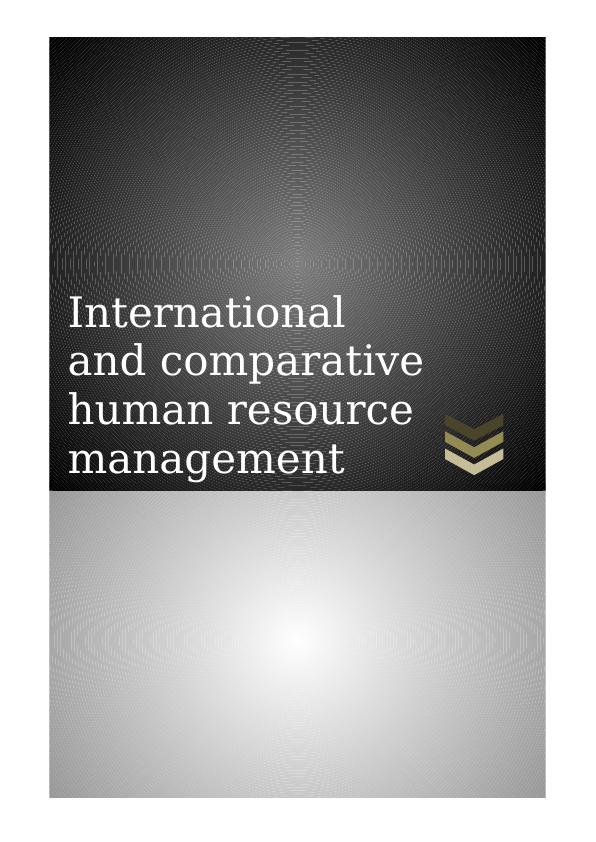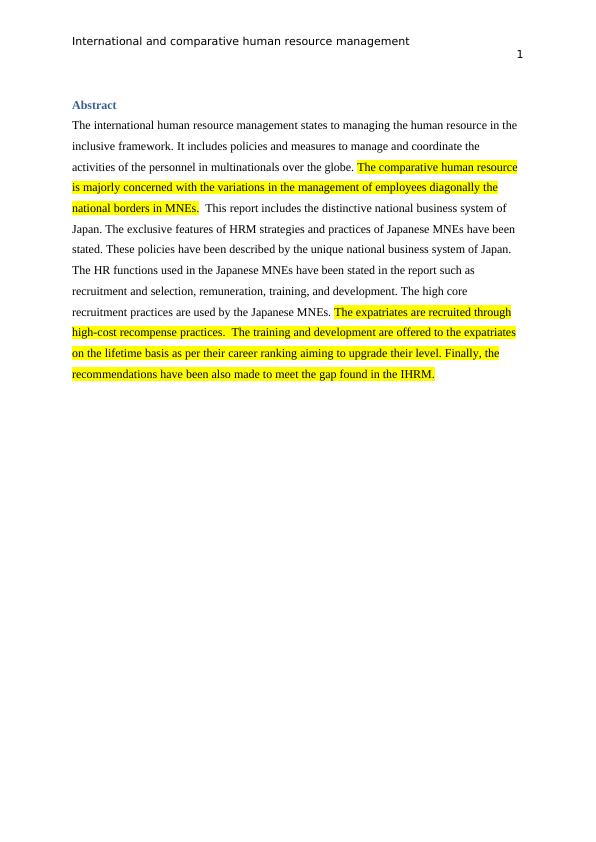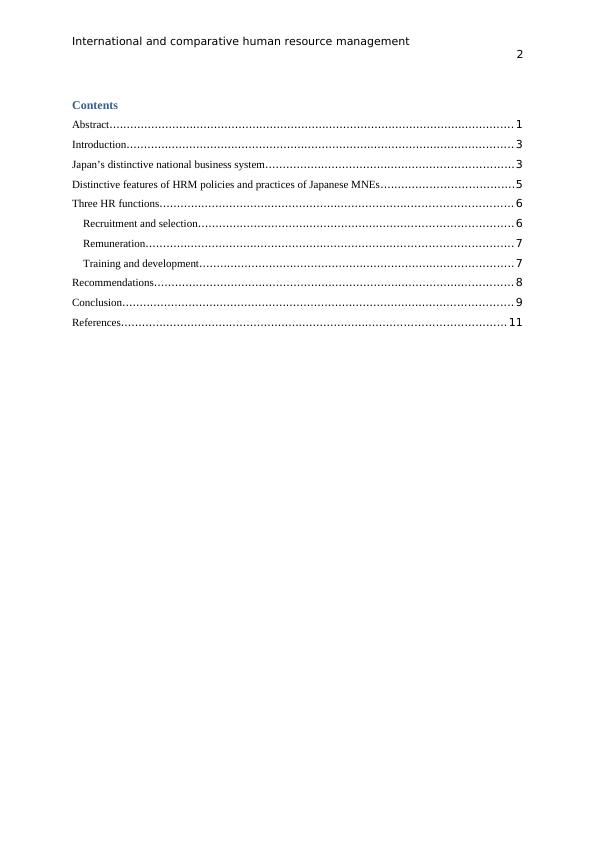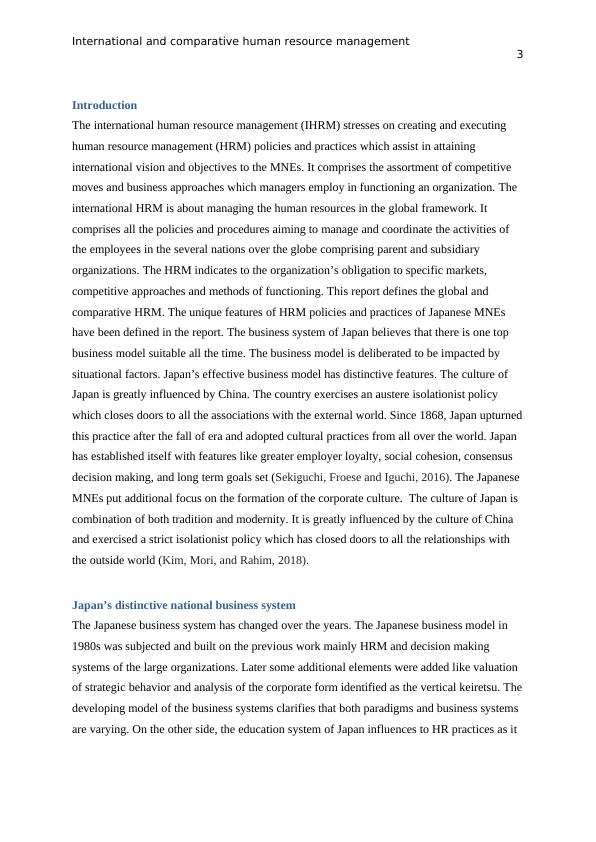International and Comparative Human Resource Management
Added on 2022-11-23
13 Pages3997 Words320 Views
International
and comparative
human resource
management
and comparative
human resource
management

International and comparative human resource management
1
Abstract
The international human resource management states to managing the human resource in the
inclusive framework. It includes policies and measures to manage and coordinate the
activities of the personnel in multinationals over the globe. The comparative human resource
is majorly concerned with the variations in the management of employees diagonally the
national borders in MNEs. This report includes the distinctive national business system of
Japan. The exclusive features of HRM strategies and practices of Japanese MNEs have been
stated. These policies have been described by the unique national business system of Japan.
The HR functions used in the Japanese MNEs have been stated in the report such as
recruitment and selection, remuneration, training, and development. The high core
recruitment practices are used by the Japanese MNEs. The expatriates are recruited through
high-cost recompense practices. The training and development are offered to the expatriates
on the lifetime basis as per their career ranking aiming to upgrade their level. Finally, the
recommendations have been also made to meet the gap found in the IHRM.
1
Abstract
The international human resource management states to managing the human resource in the
inclusive framework. It includes policies and measures to manage and coordinate the
activities of the personnel in multinationals over the globe. The comparative human resource
is majorly concerned with the variations in the management of employees diagonally the
national borders in MNEs. This report includes the distinctive national business system of
Japan. The exclusive features of HRM strategies and practices of Japanese MNEs have been
stated. These policies have been described by the unique national business system of Japan.
The HR functions used in the Japanese MNEs have been stated in the report such as
recruitment and selection, remuneration, training, and development. The high core
recruitment practices are used by the Japanese MNEs. The expatriates are recruited through
high-cost recompense practices. The training and development are offered to the expatriates
on the lifetime basis as per their career ranking aiming to upgrade their level. Finally, the
recommendations have been also made to meet the gap found in the IHRM.

International and comparative human resource management
2
Contents
Abstract.................................................................................................................... 1
Introduction............................................................................................................... 3
Japan’s distinctive national business system.......................................................................3
Distinctive features of HRM policies and practices of Japanese MNEs......................................5
Three HR functions..................................................................................................... 6
Recruitment and selection.......................................................................................... 6
Remuneration......................................................................................................... 7
Training and development.......................................................................................... 7
Recommendations....................................................................................................... 8
Conclusion................................................................................................................ 9
References.............................................................................................................. 11
2
Contents
Abstract.................................................................................................................... 1
Introduction............................................................................................................... 3
Japan’s distinctive national business system.......................................................................3
Distinctive features of HRM policies and practices of Japanese MNEs......................................5
Three HR functions..................................................................................................... 6
Recruitment and selection.......................................................................................... 6
Remuneration......................................................................................................... 7
Training and development.......................................................................................... 7
Recommendations....................................................................................................... 8
Conclusion................................................................................................................ 9
References.............................................................................................................. 11

International and comparative human resource management
3
Introduction
The international human resource management (IHRM) stresses on creating and executing
human resource management (HRM) policies and practices which assist in attaining
international vision and objectives to the MNEs. It comprises the assortment of competitive
moves and business approaches which managers employ in functioning an organization. The
international HRM is about managing the human resources in the global framework. It
comprises all the policies and procedures aiming to manage and coordinate the activities of
the employees in the several nations over the globe comprising parent and subsidiary
organizations. The HRM indicates to the organization’s obligation to specific markets,
competitive approaches and methods of functioning. This report defines the global and
comparative HRM. The unique features of HRM policies and practices of Japanese MNEs
have been defined in the report. The business system of Japan believes that there is one top
business model suitable all the time. The business model is deliberated to be impacted by
situational factors. Japan’s effective business model has distinctive features. The culture of
Japan is greatly influenced by China. The country exercises an austere isolationist policy
which closes doors to all the associations with the external world. Since 1868, Japan upturned
this practice after the fall of era and adopted cultural practices from all over the world. Japan
has established itself with features like greater employer loyalty, social cohesion, consensus
decision making, and long term goals set (Sekiguchi, Froese and Iguchi, 2016). The Japanese
MNEs put additional focus on the formation of the corporate culture. The culture of Japan is
combination of both tradition and modernity. It is greatly influenced by the culture of China
and exercised a strict isolationist policy which has closed doors to all the relationships with
the outside world (Kim, Mori, and Rahim, 2018).
Japan’s distinctive national business system
The Japanese business system has changed over the years. The Japanese business model in
1980s was subjected and built on the previous work mainly HRM and decision making
systems of the large organizations. Later some additional elements were added like valuation
of strategic behavior and analysis of the corporate form identified as the vertical keiretsu. The
developing model of the business systems clarifies that both paradigms and business systems
are varying. On the other side, the education system of Japan influences to HR practices as it
3
Introduction
The international human resource management (IHRM) stresses on creating and executing
human resource management (HRM) policies and practices which assist in attaining
international vision and objectives to the MNEs. It comprises the assortment of competitive
moves and business approaches which managers employ in functioning an organization. The
international HRM is about managing the human resources in the global framework. It
comprises all the policies and procedures aiming to manage and coordinate the activities of
the employees in the several nations over the globe comprising parent and subsidiary
organizations. The HRM indicates to the organization’s obligation to specific markets,
competitive approaches and methods of functioning. This report defines the global and
comparative HRM. The unique features of HRM policies and practices of Japanese MNEs
have been defined in the report. The business system of Japan believes that there is one top
business model suitable all the time. The business model is deliberated to be impacted by
situational factors. Japan’s effective business model has distinctive features. The culture of
Japan is greatly influenced by China. The country exercises an austere isolationist policy
which closes doors to all the associations with the external world. Since 1868, Japan upturned
this practice after the fall of era and adopted cultural practices from all over the world. Japan
has established itself with features like greater employer loyalty, social cohesion, consensus
decision making, and long term goals set (Sekiguchi, Froese and Iguchi, 2016). The Japanese
MNEs put additional focus on the formation of the corporate culture. The culture of Japan is
combination of both tradition and modernity. It is greatly influenced by the culture of China
and exercised a strict isolationist policy which has closed doors to all the relationships with
the outside world (Kim, Mori, and Rahim, 2018).
Japan’s distinctive national business system
The Japanese business system has changed over the years. The Japanese business model in
1980s was subjected and built on the previous work mainly HRM and decision making
systems of the large organizations. Later some additional elements were added like valuation
of strategic behavior and analysis of the corporate form identified as the vertical keiretsu. The
developing model of the business systems clarifies that both paradigms and business systems
are varying. On the other side, the education system of Japan influences to HR practices as it

End of preview
Want to access all the pages? Upload your documents or become a member.
Related Documents
Cultural and HRM Issues in International Business Expansionlg...
|10
|3222
|22
Cultural Issues Faced by IHRM in Global Business Expansionlg...
|10
|3226
|2
International Human Resource Management (IHRM) PDFlg...
|12
|2972
|173
MGT307 Functions of International HRMlg...
|7
|1905
|123
International Human Resource Management Issues of standardization and localizationlg...
|14
|3074
|210
International HRM Issues and Cultural Challenges in Global Business Expansionlg...
|10
|3002
|105
